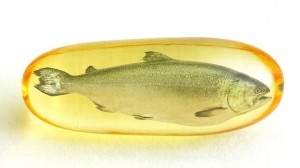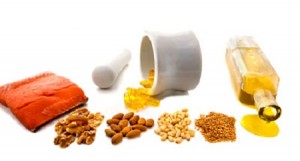Athletes are always looking for a competitive edge to improve athletic performance. Whether the end result is a 5- to 10-lb. increase in muscle mass, less muscle soreness, or a reduction in body fat, athletes will go the extra mile to find that edge. Gaining an  advantage over the opponent could mean winning a gold medal, making the final shot, or having the energy to outlast a competitor on the mat or in the ring. In addition to a balanced diet, athletes are turning to dietary supplements to gain that advantage. Popular supplements such as creatine, branched chain amino acids (BCAA’s), HMB, beta-alanine, and caffeine have been widely used throughout the athletic community. One supplement that has gained the attention of athletes is fish oil.
advantage over the opponent could mean winning a gold medal, making the final shot, or having the energy to outlast a competitor on the mat or in the ring. In addition to a balanced diet, athletes are turning to dietary supplements to gain that advantage. Popular supplements such as creatine, branched chain amino acids (BCAA’s), HMB, beta-alanine, and caffeine have been widely used throughout the athletic community. One supplement that has gained the attention of athletes is fish oil.
The growth of fish oil use among consumers has been quite impressive, as sales have risen from $425 million in 2007 to $1 billion dollars in 2012. Widely touted for its beneficial effects for cardiovascular health, fish oil has not been considered an essential piece in an athlete’s supplement regimen. In this article, I will discuss why fish oil is a critical piece to help athletes gain that competitive edge and stay in the game.
Healthy Joints, Range of Motion – Whether you’re participating in a year-round strength and conditioning program, playing multiple sports, or training at a high intensity, your muscles, joints, and tissues will experience inflammation (i.e. swelling, soreness, and redness). Inflammation is not necessarily a bad thing as this is a critical component of the recovery process. At the same time, acute and chronic inflammation may augment muscle soreness which can limit range of motion and potentially impair athletic performance. In addition, the American diet is saturated with omega-6 rich foods (fried foods, vegetable and soybean oils, salad dressings, potato chips, etc.) that promote inflammation. A diet rich in omega-3 essential fatty acids from fish (salmon, mackerel, halibut, anchovies) and/or from fish oil supplementation, can balance the effects of a diet high in omega-6 fatty acids. A study by Bloomer et al. demonstrated 4 grams of omega-3 fatty acids (2224 mg EPA + 2208 mg DHA) reduces markers of inflammation (i.e. CRP and TNF-alpha) after an intense exercise session (i.e. 60 min treadmill climb with weighted backpack). (1)
Improve Body Composition – Most people don’t expect to read about consuming fat and losing body fat in the same sentence. The essential fatty acids in fish oil (EPA and DHA) were studied in numerous animal models throughout the 80s and 90s and demonstrated a reduction in body fat (2,3) and a prevention of adipose tissue growth (4-6). Does fish oil have the same effect in humans? A study was conducted in which young, non-obese males were given 6 grams of fish oil (1100 mg EPA and 700 mg DHA) in place of 6 grams of butter, olive oil, peanut oil, or sunflower oil. After three weeks, subjects experienced a significant increase in fat oxidation and a 1.94 lb decrease in body fat (7). In a more recent study, young men and women were give 4 grams of fish oil per day (1600 mg EPA and 800 mg DHA) for six weeks vs. 4 grams of safflower oil in the placebo group. The fish oil group lost 0.5 kg of fat mass and gained 0.5 g of lean mass whereas the safflower oil group showed a tendency to gain fat mass. (8). The mechanism of action between fish oil and fat loss seems to be related to its ability to improve insulin sensitivity which improves fat burning and inhibits fat storage (9,10). Furthermore, studies have also shown fish oil supplementation can reduce the stress hormone cortisol (11), which when elevated, can result in a significant increase in fat mass (12).
Muscle Growth – Creatine, beta-alanine, HMB, and the amino acid leucine have held the title as the most popular supplements used by athletes to improve muscle strength, size, and endurance. It’s time to include omega-3 fish oil supplementation in that discussion as new science has emerged examining its anabolic potential. A recent study demonstrated 4 grams of fish oil supplementation (1.86 g EPA and 1.5 g DHA) increased protein synthesis, mTOR signaling pathway (key for muscle growth), and the muscle/protein DNA ratio (i.e. muscle cell size) (13). A similar protocol was used by the same research team to see if these effects were the same in adults over 65. Remarkably, 4 grams of fish oil supplementation increased the muscle protein synthesis response in elderly adults. (14).
How Much to Take? – The levels of omega-3 fats in your body will vary depending on the amount of omega-3 rich fish you eat or the amount of fish oil you take as a supplement. Based on the scientific evidence reported in this article, it seems 3-4 grams per day (1.5 to 2 grams of EPA and 1.5 to 2 grams of DHA) is the ideal dosage to improve joint mobility, improve body composition, and augment muscle growth.
To optimize your omega-3 levels in your blood, while also focusing on improving markers of athletic performance, take 2 grams of fish oil before and after an intense training session. For athletes participating at the collegiate, professional, or Olympic level, to reduce your risk of testing positive for a banned substance, you want a fish oil that has been tested for Sport by NSF (www.nsfsport.com), such as Nordic Naturals Ultimate Omega-D3 Sport®.
BIO: One of the leading sports nutritionist in the industry, Tavis Piattoly is the Sports  Dietitian for Tulane Athletics and the NFLPA Brain and Body Trust Program. He served as the Nutritionist for the New Orleans Saints from 2006 to 2013. He works with athletes at all levels, designing nutrition programs for peak performance. An expert on sports supplements, Tavis speaks on supplement safety for young athletes. www.mysportsdconnect.com
Dietitian for Tulane Athletics and the NFLPA Brain and Body Trust Program. He served as the Nutritionist for the New Orleans Saints from 2006 to 2013. He works with athletes at all levels, designing nutrition programs for peak performance. An expert on sports supplements, Tavis speaks on supplement safety for young athletes. www.mysportsdconnect.com
References
- Bloomer RJ, Larson DE, Fisher-Wellmann KH, Galpin AJ, Schilling BK, Effect of eicosapentaenoic and docosahexaenoic acid on resting and exercise-induced inflammatory and oxidative stress biomarkers: a randomized, placebo controlled, cross-over study. Lipids Health Disease 2009; 19:8:36.
- Hill JO, Peters JC, Lin D, Yakubu F, Greene H, Swift L, Lipid accumulation and body fat distribution is influenced by type to dietary fat fed to rats. International Journal of Obesity and Related Metabolic Disorders 1993; 17:223-236.
- Ikemoto S, Takahashi M, Tsunoda N, Maruyama K, Itakura H, Ezaki O, High Fat Diet induced hyperglycemia and obesity in mice: differential effects of dietary oils. Metabolism 1996; 45: 1539-1546.
- Belzung F, Raclot T, Groscolas R, Fish Oil n-3 fatty acids selectively limit the hypertrophy of abdominal fat depots in growing rats fed high-fat diets. The American Journal of Physiology 1993; 264: R1111-1118.
- Parish CC, Pathy DA, Angel A, Dietary Fish Oils limit adipose tissue hypertrophy in rats. Metabolism: Clinical and Experimental 1990; 39: 217-219.
- Ruzickova J, Rossmeisl M, Prazak T, Flachs P, Sponarova J, Veck M, Tvrzicka E, Bryhn M, Kopecky J, Omega-3 PUFA of marine origin limit diet induced obesity in mice by reducing cellularity of adipose tissue. Lipids 2004; 39:1177-1185.
- Couet C, Delarue J, Ritz P, Antoine JM, Lamisse F, Effect of dietary fish oil on body mass and basal fat oxidation in healthy adults. International Journal of Obesity and Related Metabolic Disorders 1997; 21:637-643.
- Noreen EE, Sass MJ, Crowe ML, Pabon VA, Brandauer J, Averill LK, Effects of supplemental fish oil on resting metabolic rate, body composition, and salivary cortisol in healthy adults. Journal of the International Society of Sports Nutrition 2010; 7:31.
- Kim HJ, Takahashi M, Ezaki O, Fish Oil feeding decreases mature sterol regulatory element-binding protein 1 (SREBP-1) by down regulation of SREBP-1c mRNA in mouse liver. A possible mechanism for down-regulation of lipogenic enzyme mRNAs. The Journal of Biological Chemistry 1999; 274: 25892-25898.
- Natatani T, Kim HJ, Kaburagi Y, Yasuda K, Ezaki O, A low fish oil inhibits SREBP-1 proteolytic cascade, while a high-fish oil feeding decreases SREBP-1 mRNA in mice liver: relationship to anti-obesity. Journal of Lipid Research 2003; 44: 369-379.
- Delarue J, Matzinger O, Binnert C, Schneiter P, Chiolero R, Tappy L, Fish Oil prevents the adrenal activation elicited by mental stress in healthy men. Diabetes and Metabolism 2003; 29:289-295.
- Bjorntorp P, Rosmond R, Obesity and Cortisol 2000; 16: 924-936.
- Smith GI, Atherton P, Reeds DN, Mohammed BS, Rankin D, Rennie MJ, Omega-3 polyunsaturated fatty acids augment the muscle protein anabolic response to hyperoinsulinemia-hyperaminoacidaemia in healthy young and middle-aged men and women. Clinical Science (London) 2011; 121 (6): 267-78.
- Smith GI, Atherton P, Reeds DN, Mohammed BS, Rankin D, Rennie MJ, Dietary omega-3 fatty acid supplementation increases the rate of muscle protein synthesis in older adults: a randomized controlled trial. American Journal of Clinical Nutrition 2011; 93 (2): 402-12.



